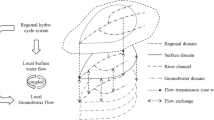Abstract
A major limitation of the use of high-resolution groundwater models on a regional scale for resource management by water companies is the excessive RAM requirements of such models which surpass the capacity of today's PCs. A strategy is presented to overcome this problem by using overlapping domain decomposition techniques. Furthermore, because very long computing time is the bottleneck for the practical use of this technique for large groundwater models, an analysis is also presented of a number of methods implemented to increase calculation performance. The approach presented here is characterized by a fairly simple structure that represents a generalized relaxation algorithm. It can be adapted for use with finite element as well as with finite difference methods.
Résumé
Une limitation majeure de la mise en oeuvre de modèles de nappe à haute résolution à l'échelle régionale pour la gestion des ressources en eau par les sociétés d'exploitation de l'eau est la grande gourmandise en mémoire vive de ces modèles, qui dépasse la capacité des micro-ordinateurs actuels. Une stratégie est présentée afin de s'affranchir de ce problème en utilisant des techniques de décomposition de domaine par superposition. De plus, parce que le très long temps de calcul est le problème de fond de l'utilisation pratique de cette technique pour les grands modèles de nappes, une analyse est également présentée d'un certain nombre de méthodes développées pour accroître les performances de calcul. L'approche présentée ici est caractérisée par une structure assez simple qui représente un algorithme généralisé de relaxation. Il peut être adapté à la mise en œuvre des méthodes aux éléments finis, comme de celles aux différences finies.
Resumen
La necesidad excesiva de memoria RAM es una de las mayores limitaciones en el uso de modelos de aguas subterráneas de alta resolución a escala regional para las compañías de gestión de recursos hídricos, ya que se sobrepasa la capacidad de las computadoras personales actuales. Se presenta una estrategia para vencer este problema mediante el uso de técnicas de descomposición de dominios superpuestos. Más aún, debido a que los elevados tiempos de cálculo suponen un cuello de botella para la aplicación práctica de esta técnica a modelos extensos, se presenta también un análisis de los métodos implementados para mejorar su rendimiento. El enfoque descrito aquí se caracteriza por una estructura relativamente sencilla que representa un algoritmo generalizado de relajación, que puede ser adaptado a su uso tanto en modelos de elementos finitos como de diferencias finitas.







Similar content being viewed by others
References
Beckie R, Wood EF, Aldama AA (1993) Mixed finite element simulation of saturated groundwater flow using a multigrid accelerated domain decomposition technique. Water Resour Res 29:3145-3157
Byrde O, Couzy W, Deville MO, Sawley ML (1999) High-performance parallel computing for incompressible flow simulations. Comput Mech 23:98–107
Dou HS, Phan-Thien N (1998) On the scalability of parallel computations on a network of workstations. Comput Mech 22:344–354
Farhat C (ed) (2000) Vistas in domain decomposition and parallel processing in computational mechanics. Computer methods in applied mechanics and engineering. 184,2/4 Spec Issue. Elsevier, Amsterdam
Fulda C, Gräsle W, Kessels W, Willert T, Zoth G (2000) Regional modeling of flow and transport in a coastal aquifer in northern Germany. In: Bjerg PL, Engesgaard P, Krom TD (eds) Proc Conf Groundwater 2000, Copenhagen, AA Balkema, Rotterdam, pp 85-86
Hackbusch W (ed) (1998) Multigrid methods V. In: Proc 5th European Multigrid Conf, Stuttgart, 1–4 Oct1996, Springer, Berlin Heidelberg New York
Kessels W, Fulda C, Binot F, Dörhöfer G, Fritz J (2001) Monitoring and modeling in the coastal aquifer test field (CAT-Field) between Bremerhaven and Cuxhaven in the northern part of Germany. In: Proc Conf Salt Water Intrusion and Coastal Aquifers—Monitoring, Modeling and Management (SWICA-M3), 23-25 April, Essaouira, Morocco
Kornhuber R (1997) Globally convergent multigrid methods for porous medium type problems. Preprint from the Konrad-Zuse-Zentrum für Informationstechnik Berlin (ZIB), SC 97-45, ftp://ftp.zib.de/pub/zib-publications/reports/SC-97-45.ps
LeBorne S (1999) Multigrid methods for convection dominated problems. PhD Thesis, University of Kiel, Germany, http://www.dissertation.de/PDF/sl90.pdf
Peaceman DW, Rachford HH (1955) The numerical solution of parabolic and elliptical differential equations. J Soc. Ind Appl Math 3:28–41
Stephen F, McCormick S (eds) (1987) Multigrid methods. Society for Industrial and Applied Mathematics, Philadelphia, 282 pp
Author information
Authors and Affiliations
Corresponding author
Rights and permissions
About this article
Cite this article
Gräsle, W., Kessels, W. A RAM-economizing domain decomposition technique for regional high-resolution groundwater simulation. Hydrogeology Journal 11, 304–310 (2003). https://doi.org/10.1007/s10040-003-0252-x
Received:
Accepted:
Published:
Issue Date:
DOI: https://doi.org/10.1007/s10040-003-0252-x




